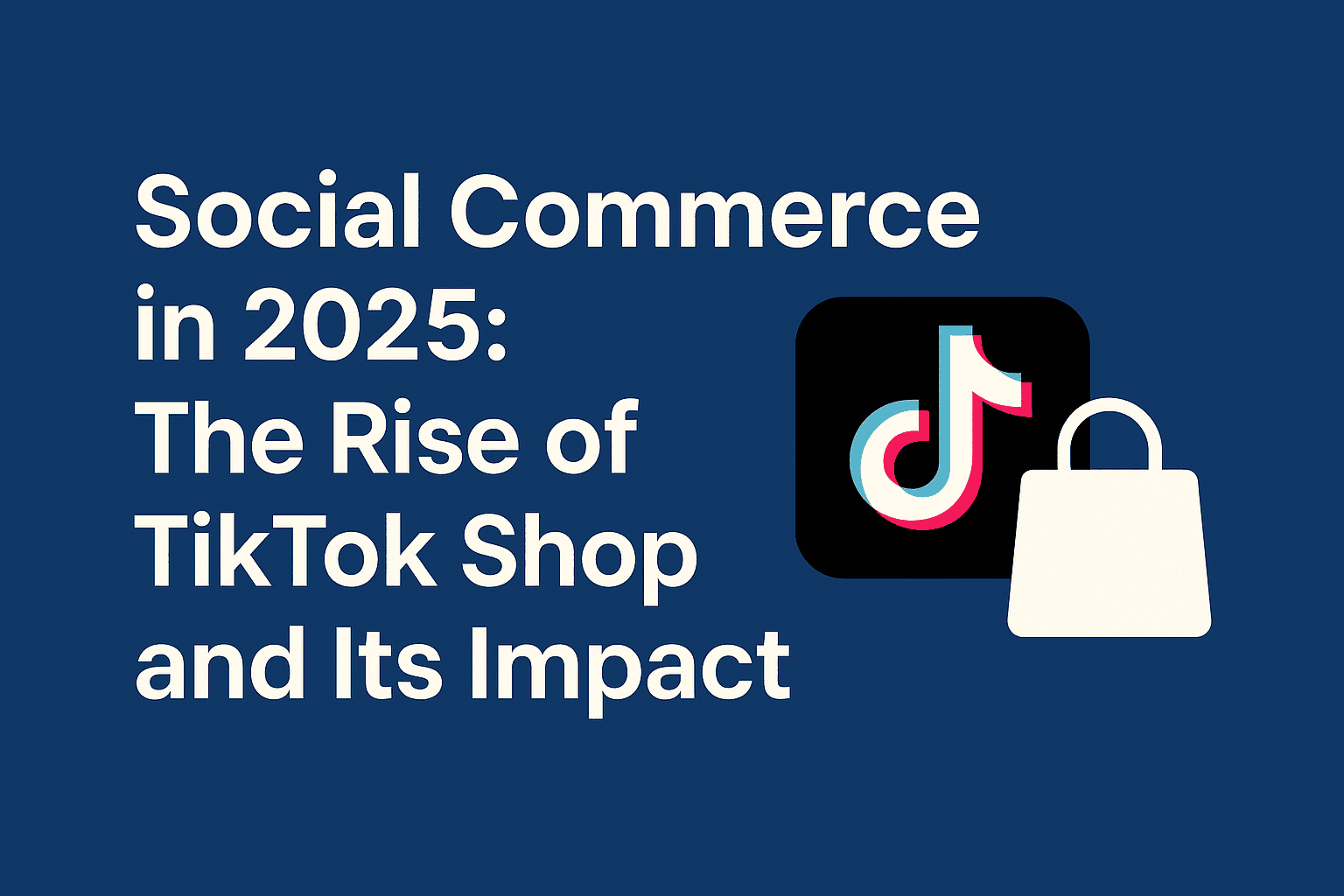Social commerce, the convergence of social media platforms and e-commerce, has been gaining substantial momentum in recent years, particularly in 2025.
As social media platforms become more sophisticated and user engagement deeper, businesses are increasingly leveraging these platforms to sell products directly to consumers. Here’s an in-depth look at the rise of social commerce and successful strategies for sellers looking to thrive in this space.
1. Key Drivers of Social Commerce Growth in 2025:
a. Younger Generations’ Preferences (Gen Z & Millennials):
-
Social commerce is overwhelmingly popular among Gen Z and Millennials, who are driving the growth of online shopping on social media platforms.
-
According to recent reports, Gen Z makes up over 40% of online shoppers and prefers the instant gratification of shopping on platforms like TikTok, Instagram, and Facebook.
-
These generations favor seamless, personalized shopping experiences that integrate social interaction, entertainment, and buying, rather than having to leave the social platform to make a purchase.
b. Algorithmic Recommendations and Content Discovery:
-
Platforms like TikTok and Instagram use advanced algorithms to surface relevant content, products, and ads based on user interests, behaviors, and previous interactions. This leads to better product discovery and an increase in impulse buys.
-
Social proof—where products are recommended by influencers, friends, or users with similar tastes—is incredibly persuasive in motivating purchases.
c. Advancement in In-App Shopping Features:
-
Social media platforms are integrating e-commerce features directly into the apps, such as Instagram Shops, TikTok Shop, and Facebook Marketplace, allowing users to buy without leaving the platform.
-
These platforms are making the buying process seamless and frictionless, which lowers the barrier for customers to make purchases and increases conversions.
Turn Yourself into an AI Barbie Doll! | Join the 2025 Viral Barbie Box Trend
d. Rise of Influencer and Creator Marketing:
-
Influencers play a huge role in driving sales through shoppable posts and live-streamed shopping events. Influencers with large followings are trusted by their audiences, and they use their platforms to share product recommendations that feel authentic.
-
TikTok’s Live Shopping and Instagram Live Shopping are key features that allow real-time interaction with viewers while offering exclusive promotions and products for immediate purchase.
e. User-Generated Content (UGC):
-
User-generated content is an integral part of social commerce. Real customer experiences and reviews often carry more weight than traditional advertising. UGC builds trust and authenticity, which in turn, drives higher sales conversions.
- Brands now actively encourage users to share their own experiences with products, further embedding shopping in everyday social interactions.
2. Successful Strategies for Sellers Using Social Commerce:
a. Leverage Shoppable Posts & Stories:
-
Utilize platforms like Instagram and TikTok to create shoppable posts and stories. These allow users to click directly on a product featured in an image or video to learn more and purchase.
-
When creating these posts, ensure they are visually appealing and tell a story—whether that’s through lifestyle shots, tutorials, or user testimonials. This helps in creating an emotional connection with potential buyers.
b. Embrace Live Streaming and Real-Time Engagement:
-
Live-stream shopping is rapidly growing. For example, TikTok’s live shopping feature and Instagram’s live shopping events provide an interactive shopping experience where sellers can promote products in real-time and engage with their audience.
-
This strategy is highly effective in converting viewers to customers, as they get to see live demonstrations, ask questions, and get instant responses.
-
Sellers should offer limited-time promotions, exclusive deals, or give product details in these sessions to entice viewers to purchase immediately.
c. Collaborate with Influencers and Micro-Influencers:
-
Influencer marketing is a cornerstone of social commerce success. Brands that collaborate with influencers or micro-influencers can tap into their loyal, engaged audiences.
-
Choose influencers who align with your brand’s values and aesthetics, and ensure they have an engaged and genuine following. The key here is authenticity—audiences are more likely to purchase products that are promoted in an authentic, relatable manner.
-
Affiliate links and discount codes provided by influencers can make the process more direct and measurable, as sellers can track conversions from these partnerships.
d. Utilize AI-Powered Personalization:
-
Social platforms like TikTok and Instagram collect vast amounts of data on user preferences, behaviors, and interactions. Sellers should take advantage of AI-powered tools to personalize the shopping experience, using these insights to target the right customers with the right products at the right time.
-
AI can help in product recommendations based on previous interactions, and dynamic pricing strategies that adapt to user behavior or market trends.
e. Offer Exclusive, Time-Limited Deals:
-
Social commerce thrives on exclusivity and urgency. Offer exclusive discounts or promotions to your social media followers that are only available for a limited time.
-
Use countdown timers on posts or stories to build excitement and increase the likelihood of impulse purchases.
-
This approach works especially well during live streaming events, where you can offer flash sales or limited-edition products to viewers in real time.
f. Engage in Social Proof and Reviews:
-
Encourage your followers to leave product reviews and share their experiences. Positive reviews and testimonials can significantly impact purchasing decisions.
-
Leverage user-generated content (UGC) by reposting real customers using your products or showcasing how they use them. This authentic content helps build trust and influences the purchasing decisions of new potential buyers.
g. Use Cross-Platform Integration:
-
Integrate your e-commerce store with multiple social media platforms to increase visibility and sales. For instance, products sold on TikTok Shop can be cross-promoted on Instagram Shopping or Facebook Marketplace.
-
Utilize shoppable ads across different platforms to reach a broader audience. By doing this, you increase the chances of conversions, as customers are more likely to purchase when they encounter your product in multiple formats and places.
h. Offer Seamless Checkout Options:
-
Ensure that your checkout process is simple and fast. Social media platforms have made strides in simplifying the checkout experience, with users able to purchase directly from posts or ads without leaving the platform.
-
Implement one-click checkout options or integrate payment gateways like Apple Pay, Google Pay, and PayPal to reduce friction in the buying process.
3. Statistics and Success Numbers in Social Commerce (2025)
-
Revenue Growth: Social commerce platforms are expected to generate $80 billion globally by 2025, with TikTok Shop and Instagram Shops leading the way.
-
Engagement Rates: TikTok boasts a 5-9% engagement rate, significantly higher than traditional e-commerce websites. Products featured on TikTok’s Shop are being discovered through virality, increasing their likelihood of purchase.
-
Conversion Rates: Social commerce platforms report an average conversion rate of 3-5%, significantly higher than traditional e-commerce, where rates typically range between 1-2%.
-
Influencer Impact: Over 60% of social media users say they’ve purchased a product directly based on an influencer’s recommendation.
7 Common Issues with TikTok Shop Orders (And How to Fix Them)
Brands Succeeding with Social Commerce on TikTok Shop
In 2025, TikTok Shop has become a dominant force in social commerce, enabling brands to reach and engage consumers in innovative ways. Here are some real-world examples of brands that have successfully leveraged TikTok Shop, along with the strategies that contributed to their success:
1. CeraVe
-
Strategy: CeraVe collaborated with dermatologists and skincare influencers to create educational and authentic content that resonated with TikTok’s audience.
-
Outcome: This approach led to a significant increase in brand awareness and sales, with CeraVe becoming one of the most recommended skincare brands on TikTok.
2. Gymshark
-
Strategy: Gymshark utilized user-generated content and influencer partnerships to showcase their products in real-life settings, emphasizing community and fitness culture.
-
Outcome: The brand experienced exponential growth, with a substantial increase in both followers and sales through TikTok Shop.
3. Drunk Elephant
-
Strategy: Drunk Elephant embraced TikTok trends and challenges, integrating their products into viral content that appealed to a younger demographic.
-
Outcome: The brand saw a surge in product visibility and consumer engagement, leading to increased sales and a stronger brand presence on TikTok.
4. Halara
-
Strategy: Halara capitalized on TikTok’s virality by creating content that highlighted the versatility and comfort of their activewear, aligning with trending topics and challenges.
-
Outcome: The brand’s products, particularly their skorts, went viral, leading to millions of views and a significant boost in sales through TikTok Shop.Wikipedia
5. Final Boss Sour
-
Strategy: Final Boss Sour collaborated with TikTok influencers to create engaging and entertaining content that showcased their unique candy products.WSJ
-
Outcome: The brand experienced viral success, with their products gaining widespread attention and leading to substantial sales through TikTok Shop.
Conclusion:
The rise of social commerce in 2025 is reshaping the way consumers interact with brands and make purchasing decisions. Social media platforms like TikTok, Instagram, and Facebook are becoming central to e-commerce, offering sellers unique opportunities to engage with their audience in a more personal, direct way.
By leveraging strategies like live shopping, influencer marketing, and personalized recommendations, sellers can tap into the growing trend of social commerce and significantly boost their sales and customer loyalty. As social platforms continue to innovate and integrate more shopping features, the future of commerce is undoubtedly social.


